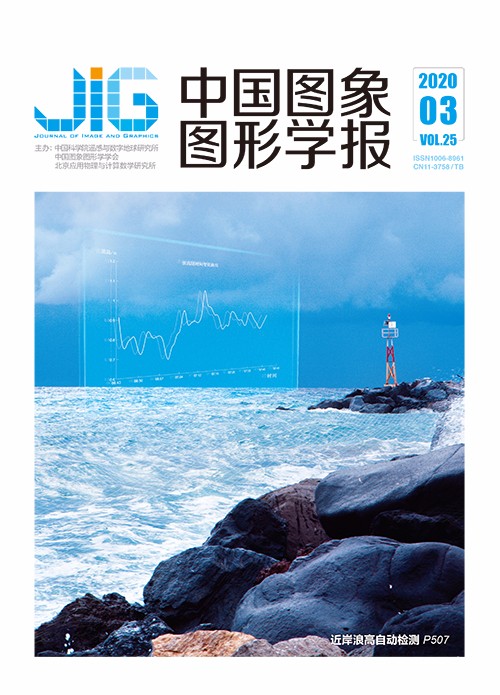
改进双边滤波Retinex的多聚焦图像融合
摘 要
目的 针对传统Retinex算法存在的泛灰、光晕、边界突出以及高曝光区域细节增强不明显的现象,将Retinex和多聚焦融合的思想融合在一起,提出一种基于Retinex的改进双边滤波的多聚焦融合算法。方法 首先根据图像情况在像素级层次将反射图像分解为最优亮暗区域两部分,然后利用线性积分变换和邻近像素最优推荐算法,将原始图像与最优亮区域多聚焦融合得到图像T,再将图像T与最优暗区域重复以上步骤得到图像S,最后利用引导滤波进行边界修复得到最终图像。结果 选择两组图像girl和boat进行实验,与SSR(single scale Retinex)、BSSR(Retinex algorithm based on bilateral filtering)、BIFT(Retinex image enhancement algorithm based on image fusion technology)和RVRG(Retinex variational model based on relative gradient regularization and its application)4种方法进行对比,本文方法在方差和信息熵两方面表现出明显优势。在均值方面,比BIFT和RVRG分别平均提高16.37和20.90;在方差方面,比BIFT和RVRG分别平均提高1.25和4.42;在信息熵方面,比BIFT和RVRG分别平均提高0.1和0.17;在平均梯度方面,比BIFT和RVRG分别平均提高1.21和0.42。对比BIFT和RVRG的实验数据,证明了本文方法的有效性。结论 实验结果表明,相比较其他图像增强算法,本文算法能更有效抑制图像的泛灰、光晕和边界突出现象,图像细节增强效果特别显著。
关键词
Improved multifocus image fusion algorithm for bilateral filtering Retinex
Chang Jian, Ren Ying, He Chunze(Liaoning Technical University, Huludao 125105, China) Abstract
Objective Many image processing models and algorithms in the field of image processing exist at present. Retinex algorithms and multifocus image fusion algorithms in the field have become the most widely used image processing algorithms because of their simplicity, efficiency, and easy implementation. However, Retinex algorithms and multifocus image fusion algorithms have limitations on image processing. This study aims to combine the algorithm with the ideas of Retinex and multifocus image fusion algorithms to achieve image enhancement. In view of the traditional Retinex algorithms, graying, halo, and boundary phenomena are considered, as well as the problem in which the details of high-exposure area is not enhanced. The traditional multifocus image fusion algorithms must capture multiple images of different focus points in the same scene, extract the focus area from multiple images of different focus points, and operate the focus area for multifocus fusion. Extracting the repeated operations of multiple image focus areas for the multifocus fusion algorithm is necessary. This study proposes a multifocus image fusion algorithm based on Retinex the improved bilateral filtering of Retinex. Method The Retinex algorithm is used to improve the process of estimating illumination images. The effects of image space proximity similarity and pixel similarity on the enhancement effect are fully considered. The improved kernel function of the traditional Retinex algorithm is enhanced to obtain an improved bilateral filter function. First, the improved bilateral filtering function is used to estimate the illumination image, and the influence of the illumination image on the visual effect is reduced or suppressed, and then the reflected image of the essence of the response image is obtained. Furthermore, the optimal parameters of the optimal bright and dark regions are calculated at the pixel level of the reflected image, and the optimal parameters are brought into the algorithm to find the optimal solution. The optimal solution can be used to decompose the reflected image into the optimal bright region and the optimal dark area. In combination with the idea of multifocus image fusion algorithms, the original image is introduced at the same time, which can ensure the enhancement effect of the image and preserve the detail and quality in the original image, so that the enhancement effect is more obvious and clear. The original image, optimal bright region image, and optimal dark region image are multifocus fusion, and the linear integral transform and adjacent pixel optimal recommendation algorithm are used to obtain a smooth and accurate steering map. The steering filter is used to further smooth the steering map. Using the processed guide map as a basis, the original image and optimal bright region are fused according to different focal lengths to obtain an image T. The image T is repeated with the optimal dark region image to obtain the process image S by the aforementioned experimental steps and finally utilized. The pilot filter performs boundary repair on the process image S to obtain a final result image. Result Pictures of a girl and a boat, which were selected for comparison experiments, with single-scale Retinex algorithm, bilateral filter-based Retinex algorithm, BIFT algorithm (Retinex image enhancement algorithm based on image fusion technology), and RVRG algorithm (Retinex variational model based on relative gradient regularization and its application). The proposed algorithm shows obvious advantages in variance and information entropy, specifically with the average of 16.37 higher than that of BIFT, and the average is increased by 20.90 compared with RVRG. The average increase is 1.25 higher compared with BIFT in terms of variance, which is an average increase of 4.42 compared with that of RVRG. In terms of information entropy, the average increase is 0.1 compared with that of BIFT, which is an average increase of 0.17 compared with that of RVRG. In terms of average gradient, the average increase was 1.21 compared with that of BIFT, which was an average increase of 0.42 compared with that of RVRG. Experimental data comparing BIFT and RVRG demonstrate the effectiveness of the proposed algorithm. The details in the original image and the dark portion of the right side of the car body in the image of the girl are significantly enhanced, and the details of the bright areas in the original image are well-preserved while being enhanced. The overall pixel value of the image is low and the visual effect is darker in the image of the boat. After the enhancement, the outline of the character is clear, the water surface is distinct, and the reef texture enhancement effect is remarkable. Conclusion The extensive experiments show that due to the uncertainty of the process of acquiring images and the complexity of image information, the traditional algorithms are inevitably limited and the enhancement effect cannot meet the high-quality requirements of image preprocessing. Compared with the traditional algorithms, the combination of Retinex and multifocus fusion algorithms proposed in this paper has a better image enhancement effect. Compared with the single-scale Retinex, bilateral filter-based Retinex, BIFT, and RVRG, the reconstructed image is superior to the contrast algorithm at the subjective and objective levels. The objective evaluation parameters of the resulting image are greatly improved, especially in terms of information entropy. The algorithm in this paper can effectively suppress image graying, halo, and boundary prominent phenomena. The contrast is significantly enhanced and has a good enhancement effect on uneven illumination images and low contrast images, making it superior to other contrast algorithms in image enhancement and robustness. The image detail enhancement effect is particularly remarkable because it serves as the foundation for the subsequent image processing.
Keywords
Retinex algorithm guided filtering optimal bright and dark regions generalized random walk improved bilateral filtering
|



 中国图象图形学报 │ 京ICP备05080539号-4 │ 本系统由
中国图象图形学报 │ 京ICP备05080539号-4 │ 本系统由